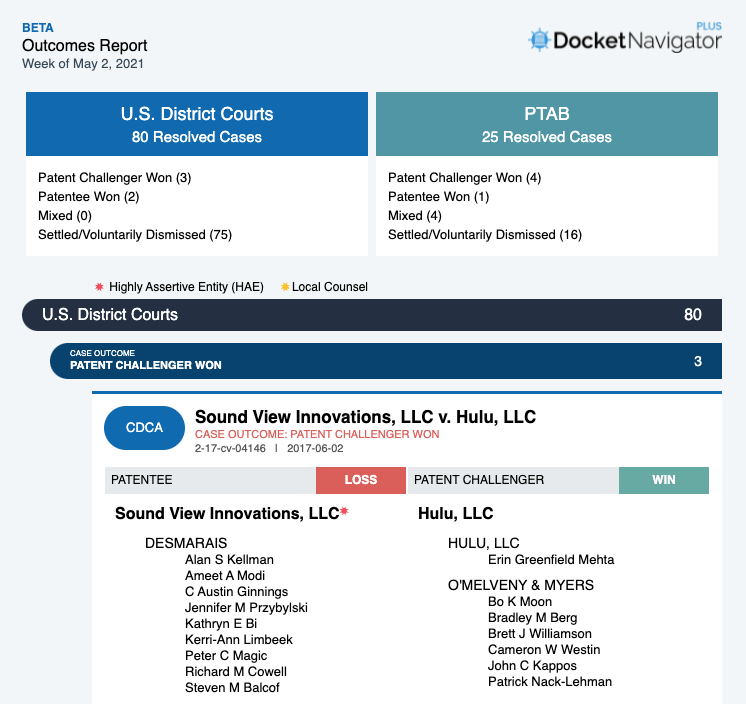How does Docket Navigator ensure the most complete and accurate reporting of litigation wins and losses possible?
Patent litigation can be messy and confusing, overwhelming even to the most experienced of judges and practitioners. To parse out the wins and losses, knowledge of case management, claim construction, patent determinations, transfers, consolidations, severances and stays is vital. Breaking cases down to the accusation level is a necessary step in the classification of winners and losers.
Extracting outcomes is a multistep process.
STEP ONE
Define Accusations
Accusations are similar in concept to a “cause of action” or a “claim for relief.” They have three basic components.
Patentee
The party that claims a right to enforce the patent at issue.
Patent Number
The number of the patent asserted by the Patentee.
Patent Challenger
The party that is either accused of infringement or is challenging the validity or enforceability of the patent. In either scenario, this party is called the Patent Challenger.
What if there are multiple parties, and/or multiple patents? Here is an example of what the Accusations look like in a case that has one Patentee asserting three patents against two Patent Challengers:
| Patentee | Patent Number | Patent Challenger |
| 5th Street Solutions LLC | 10503419 | Poly Group PLC |
| 5th Street Solutions LLC | 10503419 | Poly Limited |
| 5th Street Solutions LLC | 8664924 | Poly Group PLC |
| 5th Street Solutions LLC | 8664924 | Poly Limited |
| 5th Street Solutions LLC | 7600661 | Poly Group PLC |
| 5th Street Solutions LLC | 7600661 | Poly Limited |
STEP TWO
Assign Outcome to Accusations
Outcomes indicate whether the Accusation was resolved in the Patent Challenger’s favor, the Patentee’s favor, via settlement, or in a non-merits decision. Here is what the Accusations might look like once all questions of liability have been answered and Outcomes are applied.
Docket Navigator categorizes outcomes into these five broad categories:
| Patentee | Patent | Patent Challenger | Outcome |
| 5th Street Solutions LLC | 10503419 | Poly Group PLC | Settled/Voluntarily Dismissed |
| 5th Street Solutions LLC | 10503419 | Poly Limited | Patentee Won |
| 5th Street Solutions LLC | 8664924 | Poly Group PLC | Settled/Voluntarily Dismissed |
| 5th Street Solutions LLC | 8664924 | Poly Limited | Patent Challenger Won |
| 5th Street Solutions LLC | 7600661 | Poly Group PLC | Settled/Voluntarily Dismissed |
| 5th Street Solutions LLC | 7600661 | Poly Limited | Non-Merits Dismissal |
- Patentee Win
- If the Patentee succeeds in establishing liability (infringement of a valid, enforceable patent), this is considered a win for the Patentee.
- Patent Challenger Win
- If the Patent Challenger succeeds in establishing that a patent is invalid, unenforceable, or not infringed, this is considered a win for the Patent Challenger.
- Non-merits Dismissal
- If the accusation is dismissed on procedural grounds such that the issues of infringement, validity or enforceability are never reached, this is considered a non-merits dismissal. Common examples include Rule 12 motions.
- Mixed
- In certain forums where individual patent claims are tracked (such as the PTAB), accusations with some claims found patentable and other claims of the same patent found unpatentable, this is considered a mixed outcome.
- Settled/Voluntary Dismissal
- If the parties settle, or if a component of an Accusation is voluntarily withdrawn or dropped from the case, and the decision to do so was not prompted by an unfavorable ruling, this is classified as Settled/Voluntarily Dismissed.
STEP THREE
Assign Outcomes to Cases
In a Patent Case, the phrase “Case Outcome” can be somewhat confusing. Some claims and counterclaims in the case may be won, others lost and still others settled, making it difficult to discern who “won” or “lost” the case. In Docket Navigator, Case Outcomes are based on Accusation Outcomes. Once all of the Accusations in a case are resolved, Accusation Outcomes can be applied. Docket Navigator then categorizes Cases into five classifications based on the mix of Accusation Outcomes in those Cases.
Patentee Win
A Patentee win includes cases with only one or more of the following accusation outcomes:
- Patentee Win
- Patentee Win mixed with Settled accusation outcomes
Patent Challenger Win
A Patent Challenger win includes cases with only one or more of the following accusation outcomes:
- Patent Challenger Win
- Patent Challenger Win mixed with Settled accusation outcomes
Patent Challenger Win
A Non-Merits Dismissal includes cases with only one or more of the following accusation outcomes:
- Non-Merits Dismissal
- Non-Merits Dismissal mixed with Settled accusation outcomes
Mixed
A Mixed outcome includes cases with a combination of Patentee Win and Patent Challenger Win accusation outcomes.
Settled/Voluntarily Dismissed
Settled or Voluntarily Dismissed outcomes includes cases with only settled or voluntarily dismissed accusation outcomes.
TRACKING OUTCOMES
Weekly Outcomes Report
Docket Navigator is delighted to announce a new feature in beta, the Weekly Outcomes in Patent Litigation. It’s a great way to stay on top of the wins, losses and settlements in patent cases, with direct links to the case and individual accusation outcomes for each party.

